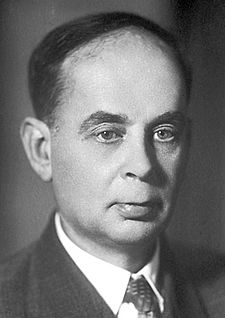Ilya Frank facts for kids
Quick facts for kids
Ilya Frank
|
|
|---|---|

Frank in 1958
|
|
| Born |
Ilya Mikhailovich Frank
23 October 1908 |
| Died | 22 June 1990 (aged 81) |
| Alma mater | Moscow State University |
| Known for | Čerenkov radiation Transition radiation Frank-Tamm formula |
| Awards | Stalin Prize 1946 Nobel Prize in Physics (1958) |
| Scientific career | |
| Fields | Nuclear physics |
| Institutions | Moscow State University, Academy of Sciences of the U.S.S.R. |
| Doctoral advisor | Sergey Ivanovich Vavilov |
Ilya Mikhailovich Frank (born October 23, 1908 – died June 22, 1990) was a famous physicist from the Soviet Union. In 1958, he won the Nobel Prize in Physics along with Pavel Cherenkov and Igor Tamm. They earned this award for their important work on something called Čerenkov radiation. Frank also received the Stalin Prize in 1946 and 1953, and the USSR State Prize in 1971.
Contents
Early Life and Education
Ilya Frank was born on October 23, 1908, in Saint Petersburg. His father, Mikhail Lyudvigovich Frank, was a skilled mathematician. His mother, Yelizaveta Mikhailovna Gratsianova, was a doctor. Ilya had an older brother, Gleb Mikhailovich Frank, who became a well-known biophysicist.
Ilya Frank studied mathematics and theoretical physics at Moscow State University. From his second year, he worked in the lab of Sergey Ivanovich Vavilov. Vavilov was a great mentor to him. After graduating in 1930, Frank began working at the State Optical Institute in Leningrad. There, he wrote his first paper about luminescence with Vavilov. This work later became his doctoral paper in 1935.
Discovering Cherenkov Radiation
In 1934, Frank moved to the Institute of Physics and Mathematics. This institute later moved to Moscow and became the Institute of Physics. Here, he started working in nuclear physics, which was a new area for him.
He became very interested in an "effect" discovered by Pavel Cherenkov. Cherenkov noticed that charged particles moving through water at high speeds would give off light.
Explaining the Effect
Together with Igor Tamm, Frank developed a scientific explanation for this effect. They found that it happens when charged particles travel through a clear material faster than the speed of light in that material. This creates a kind of shock wave in the electromagnetic field. The amount of energy released in this process is described by the Frank–Tamm formula.
Importance of the Discovery
The discovery and explanation of this effect were very important. It led to new ways of finding and measuring the speed of fast nuclear particles. This was a big step forward for research in nuclear physics.
Čerenkov radiation is also used in medical research. It helps detect radioactive isotopes, which are used in many medical tests.
In 1946, Cherenkov, Vavilov, Tamm, and Frank received a State Stalin Prize for their discovery. Then, in 1958, Cherenkov, Tamm, and Frank were awarded the Nobel Prize in Physics.
Later Career and Research
In 1944, Frank became a professor and led a department at the Institute of Physics. He also headed the Nuclear Physics Laboratory. This lab was involved in studying nuclear reactors, which was a secret project at the time. They specifically looked at how neutrons spread and slow down.
In 1957, Frank also became the director of the Laboratory of Neutron Physics. This lab was part of the Joint Institute for Nuclear Research. Under Frank's guidance, they used a special reactor to develop ways to study neutrons, called neutron spectroscopy.
Personal Life and Passing
In 1937, Frank married Ella Abramovna Beilikhis, a well-known historian. Their son, Alexander, was born that same year. Alexander later followed in his father's footsteps and became a physicist.
Ilya Frank passed away on June 22, 1990, in Moscow. He was 81 years old.
See also
 In Spanish: Iliá Frank para niños
In Spanish: Iliá Frank para niños

